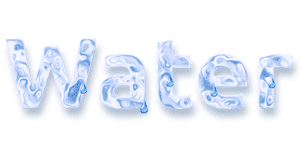Facts about Water
Posted by Admin / in Science Facts
Water is a material that is known in chemistry as 2 parts hydrogen and 1 part oxygen. Water is a very important material for Earth, the way we know it, and for life on our planet. Without water there would be no plants, animals and people. Water helps create a perfect environment for life to thrive on Earth. Think of the lakes, rivers and oceans or even the rain and snow. Life in the water helps support life on land. Water evaporates from the surface water and returns as rain or snow to the land, allowing plants to grow and providing water for people and animals.

Water is 2 parts hydrogen and 1 part oxygen
Water on Earth
Water is plentiful on Earth. Over 75 percent of the Earth's surface is water. Even the land contains water. Over 30 percent of the known fresh water is contained underground. Without water, there would be no life on Earth. Many space missions have a goal of finding water. Why, because where there is water, there is a chance of life.

75% of the Earth's Surface is Water

Each person in America uses approximately 90 gallons of water each day
Interesting Water Facts
FACTS ABOUT WATER
-
Water consists of 3 phases including liquid water, solid ice and water vapor gas (clouds and fog). We consider these 3 phases the main path of the water cycle.
-
Nearly 75 percent of the Earth surface is covered by water.
-
Liquid water has two categories including fresh water and saltwater.
-
96.5 percent of the earth's water is located in oceans and seas, including bays and intercoastal waterways
-
Almost 69 percent of the world's fresh water supply is located in glaciers and permanent snow near the Earth's north and south poles.
-
Over 30 percent of the world's fresh water supply is groundwater.
-
The remaining amount of fresh water(less than 1%) is located in rivers, ponds, lakes, swamps and water in the atmosphere.
WATER CHEMISTRY FACTS
-
Water freezes at 32 degrees F (0 degrees C).
-
Water boils at 212 degrees F.
-
Water is the only substance that can change phases from solid to liquid to gas in a small range of naturally occurring temperature.
-
Water is pretty heavy. It weighs 62.4 pounds per cubic foot.
-
Water has an unusually high amount of surface tension. The water molecules pull together. We see this effect with rain drops, bugs floating on the water and groundwater moving up into trees and plants. All these natural phenomena are a result of the surface tension of water.
-
Most natural (non-organic) solids are heavier than water. Ice is an exception. Frozen water, also known as ice, is lighter than water and will float.
-
In its natural state, water has a pH of 7, which means it is neutral (not an acid or an alkaline). Water effected by pollution such as acid rain, mine runoff and farm runoff, however, typically have a pH lower than 7. Salt water and runoff and ground water near limestone have a pH higher than 7.
